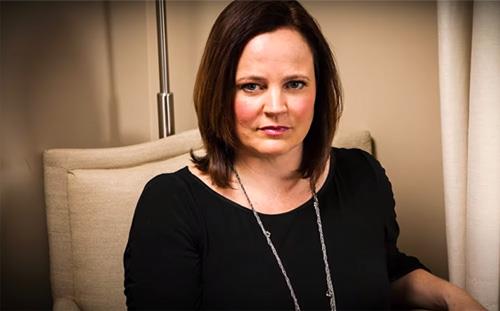
Brace yourself if you want to watch I’ll Be Gone In the Dark, a new six-part HBO series about the hunt for a California serial rapist and murderer.
It’s a ride down 40 miles of bad road.
I’ll Be Gone in the Dark, which premieres Sunday at 10 p.m. ET on HBO, adapts the book of the same name by Michelle McNamara (top), in which she details her multi-year hunt for clues to the then-unsolved crimes.
McNamara, who died in 2016 before the book could be published, was a self-confessed obsessive who decided there must be a way to find the hooded man who had raped more than 50 women and killed at least a dozen from 1974 to 1986.
He had a couple of media nicknames, and McNamara coined one of her own: The Golden State Killer, which eventually became the most popular of the lot.
In a series of taped commentaries and through a podcast she hosted, McNamara explained that her ultimate goal was justice for the victims – but that in the process, she became psychologically bonded to the case herself.
Even, in a weird way, to the killer.
McNamara’s work did eventually help lead to a resolution. A man was arrested after her death, and just this past week pleaded guilty in return for not facing the death penalty.
I’ll Be Gone In the Dark doesn’t go into that postscript. Filmmaker Liz Garbus focuses instead on McNamara’s chronicle of her search, which took her to some dark corners.
She went into places like true-crime chat rooms, which obviously were not available to investigators in 1975, looking to mine any actual information someone might have to offer.
Most of her work, though, just involved long hours of old-fashioned persistence. She obtained and read through tens of thousands of pages of documents from police investigations, newspaper accounts, and public records. She talked with detectives who had worked the cases.
This is way less glamorous than the way it’s portrayed on most police dramas, where someone quickly finds exactly the right document that has precisely the piece of information that ties the whole puzzle together.
As McNamara notes along the way, she was one person doing what a whole bunch of cops and detectives had done years earlier. She was looking for anything that would inch her understanding a tiny bit forward, in hopes that after years of inching, she might be far enough along to eliminate or target a suspect.
What she also found, as she notes in her book and Garbus reflects in the docuseries, is that this long process kept increasing her personal stake in the case, and in the identity of the perp.
Internalizing clearly took its toll, though she also spoke of a periodic bizarre sense of pleasure when something came together.
That psychological undercurrent makes McNamara’s story interesting and also a bit disturbing. What’s more disturbing, however, is that tracing her journey requires us to continuously revisit the crimes themselves.
Garbus talks with a number of rape victims, whose stories all include the same terrible elements, including the rapist's need to humiliate the victim, issue lethal threats, and revel in his power.
While the murder victims obviously can’t speak, the perpetrator’s escalation from rape to murder doesn’t seem to have been a big leap.
McNamara discussed how getting away with these serial crimes for a dozen years, and then another three decades after the crimes stopped, might have created an aura around him – that he was some kind of warped, demented genius, a man of fascination.
She also suggested that when he was apprehended, all that would vanish. He would hold no more power and no more fascination.
She was right. The man who was arrested seems simply ordinary, possessing no charisma or aura – and now, in the end, no power.
That’s not a happy ending, by the way. It’s only better than the alternative of never identifying him.
After a six-episode immersion into the depravity of what he did, viewers will admire McNamara and admire Garbus. But they still may want to step outside for some air.